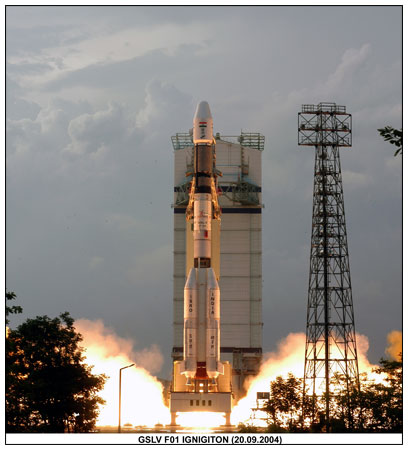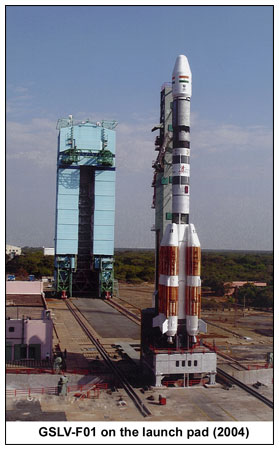
After many delays, the Indian Space Research Organisation (ISRO) is primed to fly its Geostationary Satellite Launch Vehicle (GSLV) Mark II rocket on Monday, 19 August to deliver the GSAT-14 communications satellite into orbit. Liftoff has been postponed repeatedly since last October, due to ongoing tests of a home-grown Indigenous Cryogenic Upper Stage, which will be making its second flight, and the need to resolve issues which caused the loss of the previous Mark II mission in April 2010.
Unlike the Mark I GSLV, the Mark II does not rely upon a Russian-built third stage, which ISRO has blamed for failing to operate properly on several occasions, triggering multiple mission failures. The new variant is reportedly capable of delivering a payload weighing up to 11,000 pounds into low-Earth orbit and up to about 5,000 pounds into geostationary transfer orbit, but both types of the GSLV have thus far exhibited a dismal success record. Launched seven times between April 2001 and December 2010, it has suffered four outright Losses of Vehicle and Payload, one mission in which its satellite cargo was inserted into an improper orbit, and only two full successes.

The three-stage GSLV stands 161 feet tall and was originally conceived as a means of eliminating India’s reliance upon foreign rockets for its geostationary-orbiting satellites. It utilizes components of the highly reliable Polar Satellite Launch Vehicle (PSLV) and comprises a first stage fed by a single solid-fueled engine and four strap-on liquid-fueled boosters, topped by liquid-fueled second and third stages. The first stage solid fuel is hydroxyl terminated polybutadiene, whilst the Vikas engines of the strap-on boosters are powered by unsymmetrical dimethyl hydrazine and nitrogen tetroxide; combined, these generate 610,000 pounds of propulsive yield at liftoff.
After launch, the first stage burns for approximately two minutes. Following the separation of both it and the four boosters, the second stage—fueled by unsymmetrical dimethyl hydrazine and nitrogen tetroxide—will ignite, its Vikas engine burning fiercely with 160,000 pounds of thrust for 150 seconds to continue the climb toward orbit. Finally, the cryogenic third stage, which operates on liquid hydrogen and oxygen in a pair of separate aluminum tanks connected by an inter-stage, will burn with 16,500 pounds of thrust to propel the GSAT-14 payload into geostationary transfer orbit. Throughout ascent, S-band telemetry and C-band transponders will enable controllers to continuously monitor vehicle parameters, including tracking, range safety, and preliminary orbit insertion.
Monday’s launch, as with all previous GLSVs, will occur from the Satish Dhawan Space Centre on the barrier island of Sriharikota, within India’s southern state of Andhra Pradesh. According to ISRO, liftoff is scheduled for 4:50 p.m. India Standard Time (12:20 p.m. UTC). However, the vehicle will have much to prove on its first foray in three years. Its maiden (“Development-1,” or “D1”) voyage in April 2001, flying in the Mark I(a) configuration, suffered an engine shortfall when its Russian-built upper stage burned for 12 seconds less than planned. This delivered the GSAT-1 payload into an improper orbit, whose apogee was 2,500 miles lower than intended. Although ground controllers managed to nudge the satellite toward geostationary orbit, they did so at the expense of using all of its attitude control propellant, and GSAT-1’s tasks of digital audio broadcasting, compressed digital television signal transmission, and associated internet services could not be achieved.
Success was finally achieved two years later, in May 2003, when a second Mark I(a) vehicle flew the “D2” mission and placed GSAT-2 into geostationary orbit. Perhaps a little prematurely, the GSLV was declared operational, and in September 2004 it carried the EDUSAT/GSAT-3 payload into orbit to handle India’s demands for an interactive satellite-based education system. However, success and failure went hand in hand, and in July 2006 the uprated Mark I(b) configuration veered outside permitted limits during ascent and had to be remotely destroyed over the Bay of Bengal by the range safety officer. Its primary payload—the Insat-4C multi-purpose satellite—was lost in the accident.

Another Loss of Vehicle event occurred in September 2007, when a Mark I(b) suffered an underperformance of its third stage and failed to deliver Insat-4CR into geostationary orbit, due to a guidance system error. The satellite was eventually maneuvered into its proper orbit by ground controllers, but at the expense of reducing its operational lifetime from ten to five years. Two more failures followed. The first flight of the new Mark II vehicle (“D3”) in April 2010, with its ISRO-designed cryogenic third stage, developed a turbopump fault and resulted in the loss of the GSAT-4 communications and navigation satellite. This would have been India’s first spacecraft to utilize ion propulsion. Most recently, on the “D4” mission in December 2010, a Mark I(c) was lost when its four liquid-fueled boosters failed to respond to commands, and the vehicle and GSAT-5P communications satellite payload had to be destroyed by the range safety officer.
Late in 2011, S. Ramakrishnan, head of ISRO’s Liquid Propulsion Systems Centre (LPSC) at Mahendragiri, declared that the D3 turbopump fault had been isolated, corrective actions taken, and computer simulations concluded and validated. “We did a thorough analysis of the D3 flight and identified the reasons behind its failure,” explained P.S. Veerarghavan, director of Vikram Sarabhai Space Centre, quoted last year. “The analysis called for a redesign of certain components in the cryogenic propulsion system and the same has now been addressed and is being put through multiple testing.” Key focuses included high-altitude “hot-fire” tests to verify the performance of the third stage turbopump. Other recommended steps included strengthening the payload shroud.
In early May 2013, the Indian-built Indigenous Cryogenic Upper Stage for Monday’s “D5” mission was transferred from LPSC Mahendragiri to Sriharikota for final checkout. On 5 July, the process of integrating the upper stage with the lower two stages of the GSLV got underway. Assuming a successful climb to orbit, the rocket will deliver GSAT-14 as a replacement for the EDUSAT/GSAT-3, which has been operational in orbit for almost a decade. The 4,400-pound satellite is equipped with six Ku-band and six C-band transponders, which will cover the entire subcontinent of India, together with Ka-band beacons for studying the impact of climate on the Ka-band satellite communications links in the region.
Although Monday’s GSLV-D5 mission is scheduled to last barely 17 minutes and 8 seconds, from liftoff through payload separation, its criticality of success cannot be understated. India has expressed its urgent requirement for a reliable cryogenic upper stage to boost its large satellites to geostationary altitudes. This will serve to end its reliance upon foreign launch vehicles, most notably Europe’s Ariane, and success will stand the GSLV in better stead to serve as the carrier for the long-awaited Chandrayaan-2 mission in 2015. The latter will place a spacecraft into orbit around the Moon and deploy a landing craft and a single roving vehicle to touch down on the surface. Although this will be India’s second mission to the Moon, it will be markedly more complex than its predecessor, the 2008-launched Chandrayaan-1.
Want to keep up-to-date with all things space? Be sure to “Like” AmericaSpace on Facebook and follow us on Twitter:@AmericaSpace



